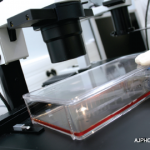Myopathy is the medical term for muscle disease. Patients with myopathy develop weakness in the large muscles around the neck, shoulders, and hips. This causes difficulty in climbing stairs, getting up from a chair or toilet seat, or reaching for objects overhead. Some patients with myopathy develop weakness of the throat muscles involved in swallowing, and this may cause choking or aspiration of food into the lungs when eating. Others may experience shortness of breath and cough due to inflammation of the lungs.
Two types of inflammatory myopathies are polymyositis and dermatomyositis. Polymyositis is an inflammation of the muscle tissue that leads to weakness, and dermatomyositis is characterized by immune inflammation of muscles, as well as by the presence of a rash. This rash, which appears as a purple or red discoloration of the upper eyelids, is present in almost all children with inflammatory myopathy. “People with dermatomyositis may also have lung inflammation (pneumonitis), and children may have an inflammation of the blood vessels and calcium deposits in the skin referred to as calcinosis,” explains patient fact sheet author Marc Miller, MD, of Rheumatology Associates in Portland, Maine.
Inflammatory myopathies are rare diseases, and polymyositis and dermatomyositis occur in approximately one person in 100,000. All age groups are affected, with peak incidence between the ages of five and 10 in children and between the ages of 40 and 50 in adults. Women are affected about twice as often as men, all ethnic groups are affected, and it is not possible at this time to predict who will develop an inflammatory myopathy.
A diagnosis of myopathy is suspected when patients complain of difficulty performing tasks that require muscle strength or when they develop certain rashes or respiratory problems. To establish a diagnosis, perform a muscle-strength examination to determine if true muscle weakness is present. This likely will be followed by a blood test to measure the level of various muscle enzymes, an electromyogram to gauge electrical activity in muscle, and finally a biopsy of a weak muscle. Sometimes MRI scanning can help to establish the presence of abnormal muscle.
Treatment depends on the type of myopathy diagnosed. Polymyositis and dermatomyositis are usually treated with medications. An oral corticosteroid, such as prednisone, is usually administered in high doses once the diagnosis has been established. “Methotrexate or azathioprine are usually added to ensure better long-term control of the disease and to avoid long-term side effects of cortisone,” explains Dr. Miller. In severe or treatment-resistant cases, additional measures may include intravenous immunoglobulin and other immunosuppressive medications.

